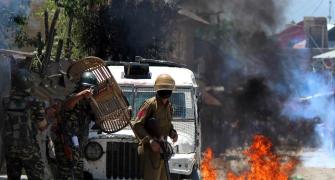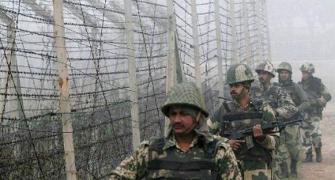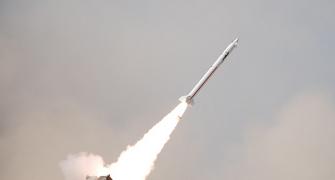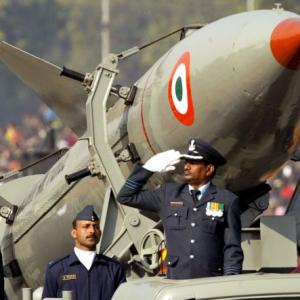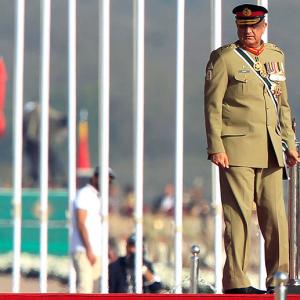For the world and India, one of the most enduring challenges of the times is for Pakistan's nukes to be neutralised, before they are ever used by the State, their sponsored non-State actors or any rogue elements from the many terror tanzeems dotting Pakistan's unstable landscape, says Lieutenant General Kamal Davar (retd).
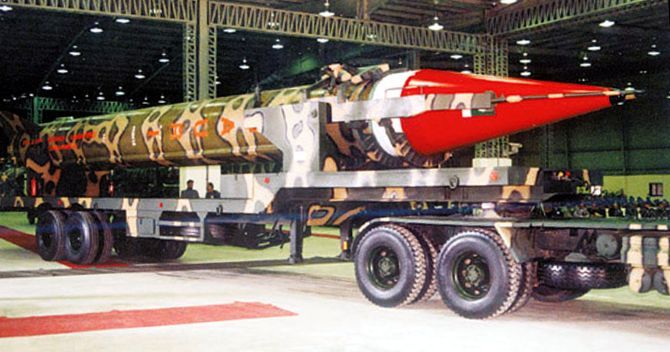
IMAGE: A Ghauri missile, with a range of 1,500 km on a mobile launch-pad at an undisclosed location in Pakistan. Photograph: Pakistan military department/Handout/Reuters
Pakistan has a total of 15 nuclear sites, of which only three -- Karachi, Chashma and PINSTECH --are under IAEA safeguards.
Others are under the control of the army and remain unsafeguarded. Additional plutonium enrichment plants are coming up at PINSTECH.
Reportedly, Pakistan produces HEU at a rate of 100 kg per year. Its HEU-based warheads require between 15 and 20 kg of HEU each.
Pakistan is also producing plutonium for plutonium-based warheads to which they are changing over from HEU.
It is reported to have the fastest growing nuclear arsenal in the world with estimates of 120 to 140 warheads in its possession.
The development of Pakistan's nuclear delivery systems has been assisted mainly by China and North Korea, while some systems are indigenously produced.
Pakistan's delivery vehicles include modified F-16A/B aircraft and a few Mirage V and Chinese-built A-5 Fantans, under the control of the Pakistan air force and a variety of surface-to-surface missile systems under the control of the army.
The F-16s are likely based at the Sargodha air base, located 160 km northwest of Lahore.
In August 2007 and May 2008, Pakistan tested the air-launched cruise missile (ALCM) Ra’ad (Hatf VIII), which is claimed to be nuclear capable possessing a range of 350 km.
Pakistan has three ballistic missiles that are supposedly nuclear capable -- the solid fuel Hatf III (Ghaznavi) which has a range of 300 km to 400 km; solid fuel Hatf IV (Shaheen) with a range of 450 km and the liquid fuel Hatf V (Ghauri) with an approximate range of 1,300 km to 1,500 km.
In addition, Pakistan is developing the Hatf VI (Shaheen II) which will have a range of 2,000 km.
It also claims to have developed the much heralded TNWs, like the 60 km range Nasr and the short-range Abdali, to counter India's Cold Start doctrine.
The Pakistan army's official press release calls these TNWs part of a 'quick response system which addresses the need to deter evolving threats'.
Sea-based systems are also under development, including the potential purchase of six Qing-class diesel submarines, which would enhance Pakistan's second-strike capability.
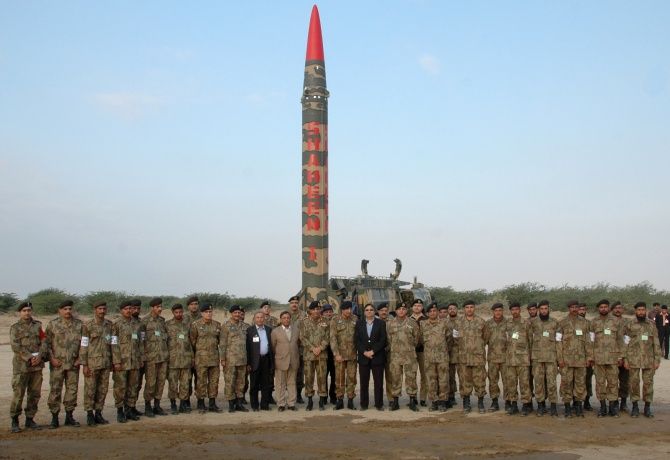
IMAGE: Then Pakistan prime minister Shaukat Aziz, fifth from left, at the launch of the surface to surface nuclear-capable ballistic missile HATF-V Ghaznavi, with a range of 1,500 km and a payload of 900 kg. Photograph: Pakistani military department/Inter Services Public Department/ISPR/Reuters
The lowering of Pakistan's nuclear threshold is of greater concern than the prospect of nuclear terrorism due to theft of fissile material.
This aspect is worrisome not only for India and the West, but even for Pakistan. But it claims that its nuclear arsenal is well protected by the army's 20,000-strong SPD, which takes its orders from Pakistan's Nuclear Command Authority.
For Pakistan, its nuclear arsenal is an instrument that allows it to wage offensive proxy war and, concurrently, provides it defence against retaliatory punitive action from India.
Pakistan's nuclear weapons are a strategic equaliser of power asymmetry, that is, they are supposed to balance India's conventional military superiority.
Additionally, the Pakistanis have used their nuclear capability to extract maximum aid from the US, China, Europe and some nations in West Asia.
At the outset, it must be understood that the growth of Pakistan's nuclear programme, conduct of proxy war through terrorism based on an undue faith in its own nukes, its obsessive revisionist agenda for Kashmir and India's proverbial strategic patience, will ensure that strategic stability and mutual deterrence, which is customarily possible between two nuclear-weaponised States, is not likely between India and Pakistan.
Importantly, China's support for Pakistan's nuclear programme with assistance in weapons, missiles, reactors and fissile material will continue to drive instability in the Indo-Pak dyad.
Pakistan does not have a declared nuclear doctrine and neither has there been any clear articulation of its guiding tenets.
As early as 2001, the first and renowned director general of Pakistan's SPD, Lieutenant General Khalid Kidwai, in a well-publicised statement of Pakistan's nuclear intent underscored its employment of nuclear weapons. His nation's thresholds were military, economic, political and survival.
At various seminars, he has listed circumstances in the nuclear command authority which Pakistan would respond to a conventional attack with nuclear weapons: 'India attacks Pakistan and conquers a large part of its territory. India destroys a large part of Pakistan's land or air forces. India blockades Pakistan in an effort to strangle it economically, India pushes Pakistan into a state of political destabilisation or creates large-scale internal subversion in the country.'
While these verges were some indication of Pakistan's restraint levels, the statement was quickly revoked.
Officially, there remains no policy declaration on the grounds that any stated doctrine would create space for conventional conflict.
The contradiction here is particularly stark coming in the wake of the Kargil conflict, the assault on the Indian Parliament and the continuing use of jihadists as part of military strategy.
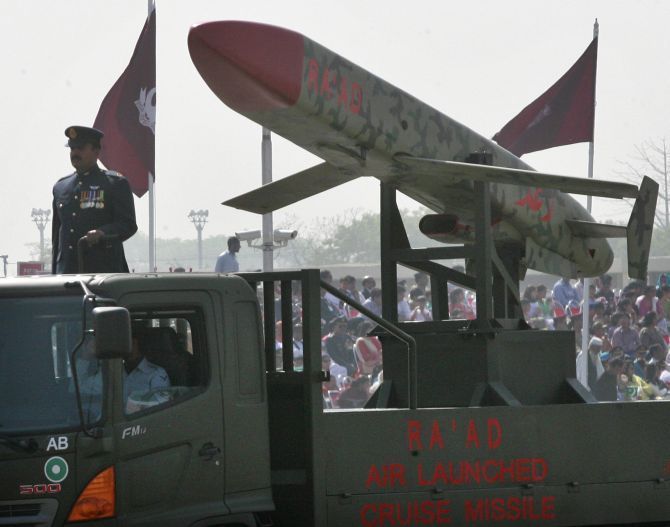
IMAGE: Pakistan has developed nuclear-capable short-range missiles that appear to be intended for tactical nuclear roles and missions with their purpose apparently to off set India's superior conventional forces in limited conflict scenarios. Photograph: Mian Khursheed/Reuters
In another statement, some years earlier, former army chief General Aslam Beg stated, 'An attack by any nation on our nuclear arsenal will automatically trigger a nuclear strike on India.'
Weird as this may sound, it is clear that Pakistan retains a certain irrational ambiguity in its policy to use nuclear weapons.
The Pakistan army has embedded the use of nuclear weapons in their overall military strategy and doctrine as they opine that in their strategy of 'flexible response', escalation from conventional to the nuclear is always possible.
However, in their stated stance they have rightly surmised that nuclear weapons are political weapons to be employed as a last resort and that their possession may avoid conflicts.
Pertaining to Pakistan itself, it is appreciated that 'on the matrix of a larger power-smaller power equation, such a capability provides to the smaller an unreserved strategic equivalence'.
Thus, through ambiguities and a threat of first use, Pakistan has ensured the absence of a formal declaratory policy.
Accordingly, the Indian security establishment will have to factor in Pakistan’s deliberate nuclear subterfuge in its preparations.
In summation, Pakistan's nuclear strategy embraces the under-mentioned facets:
- Pakistan has not abjured the First Use of Nuclear Weapons doctrine and their usage forms an integral part of its military strategy.
- It has taken recourse to deliberately projecting ambiguity in its overall nuclear strategy.
- The military is both the custodian and controller of nuclear assets and professes to have in place a robust command and control system. With fundamentalism on the rise and having penetrated into the services and with terrorists also on the prowl for stealing fissile materials, the dangers of nuclear materials pilferage/safety of nuclear assets remains a major problem.
- China's assistance to Pakistan's nuclear weapons programme is a critical asset for Pakistan with newer technologies, doctrines, command and control facilities and additional lethal infusions of missiles.
- Though Pakistan's nuclear weapons programme and strategy is 'India-specific', it does not recognise India's NFU-declared nuclear intent, rejecting it on the grounds that India may not stick to its declared policy during hostilities.
- Pakistan's development and deployment of TNWs is primarily to prevent India from launching its battle groups as part of its Proactive Doctrine. With TNWs, Pakistan has lowered its nuclear threshold, which now results in the creation of additional strategic instability in the subcontinent.
- Pakistan is now shoring up its second-strike capability with the development of the sea-launched submarine cruise missile Babur III, which is likely to have a range of 450 km. It is reportedly moving its major submarine base from Karachi to Ormara as it feels Karachi's closeness to the Indian border makes it more vulnerable.
* * *
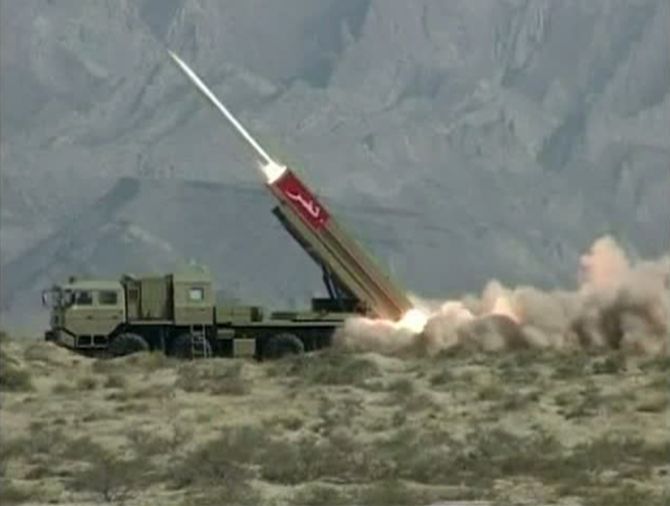
IMAGE: This image from a Pakistan military handout video shows a Hatf IX (NASR) missile being fired during a test. Photograph: Pakistan military Inter Services Public Relations via Reuters TV/ Handout/Reuters
Considering that Pakistan faces internal stability and self-created terror threats from within, escalating law and order and security problems within its restive provinces of Balochistan and to some extent in Sindh, KPK, FATA and areas along the Durand Line, its obsession with nukes may turn out to be self-defeating in the long run.
If it wishes to continue brandishing its nuclear card, it may wish to heed to Michael Krepon's advice that 'escalation control and the nuclear option is a subject matter proven to be remarkably resistant to sensible analysis.'
For the world and India, one of the most enduring challenges of the times is for Pakistan's nukes to be neutralised, before they are ever used by the State, their sponsored non-State actors or any rogue elements from the many terror tanzeems dotting Pakistan's unstable landscape.
Excerpted from Tryst With Perfidy: The Deep State Of Pakistan by Kamal Davar with the permission of the publishers, Rupa Publications.

